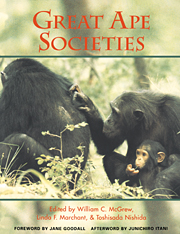Book contents
- Frontmatter
- Contents
- List of contributors
- Preface
- Foreword: conserving great apes
- Part I Apes overviewed
- Part II Social ecology
- Part III Social relations
- 8 Social grouping in Taï chimpanzees
- 9 Coalition strategies among adult male chimpanzees of the Mahale Mountains, Tanzania
- 10 Male rank order and copulation rate in a unit-group of bonobos at Wamba, Zaïre
- 11 Comparing copulations of chimpanzees and bonobos: do females exhibit proceptivity or receptivity?
- Part IV Minds
- Part V Apes compared
- Part VI Modeling ourselves
- Afterword: a new milestone in great ape research
- Appendix: great ape study sites
- Index
10 - Male rank order and copulation rate in a unit-group of bonobos at Wamba, Zaïre
Published online by Cambridge University Press: 04 August 2010
- Frontmatter
- Contents
- List of contributors
- Preface
- Foreword: conserving great apes
- Part I Apes overviewed
- Part II Social ecology
- Part III Social relations
- 8 Social grouping in Taï chimpanzees
- 9 Coalition strategies among adult male chimpanzees of the Mahale Mountains, Tanzania
- 10 Male rank order and copulation rate in a unit-group of bonobos at Wamba, Zaïre
- 11 Comparing copulations of chimpanzees and bonobos: do females exhibit proceptivity or receptivity?
- Part IV Minds
- Part V Apes compared
- Part VI Modeling ourselves
- Afterword: a new milestone in great ape research
- Appendix: great ape study sites
- Index
Summary
INTRODUCTION
The view that male–male sexual competition is lower in bonobos than in chimpanzees has recently been proposed (e.g. Ihobe, 1992; Kano, 1992). This view is based on the estimation that more estrous females are available to a male bonobo than to a male chimpanzee. (1) Maximal or semi-maximal perineal tumescence in adult females lasts for more than 20 days for bonobos at Wamba (Kano, 1992), whereas average durations of maximal tumescence for adult female chimpanzees are 9.6 and 12.5 days at Gombe and Mahale, respectively (Nishida & Hiraiwa-Hasegawa, 1987; Takahata et al., Chapter 11). There is no marked difference in cycle length, and in both species most copulations occur when females show sexual swelling (Takahata et al., Chapter 11). Hence, the sexually receptive proportion of each cycle is greater in bonobo females than in their chimpanzee counterparts. (2) Young nulliparous immigrant females of bonobos show continual estrus and the highest copulation rates (Kano, 1989). Although chimpanzee adolescent females also show semi-continuity or irregularity in genital swelling (Tutin & McGrew, 1973), they mate much less frequently with adult males (Goodall, 1968). This implies that male bonobos are attracted to adolescent swellings, while male chimpanzees are not. (3) Females of both species experience estrous cycles after conception, but sexual receptivity in pregnant bonobos appears to last longer.
- Type
- Chapter
- Information
- Great Ape Societies , pp. 135 - 145Publisher: Cambridge University PressPrint publication year: 1996
- 20
- Cited by



